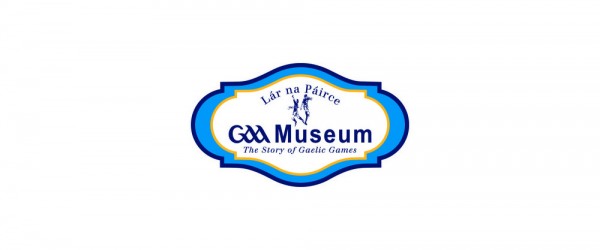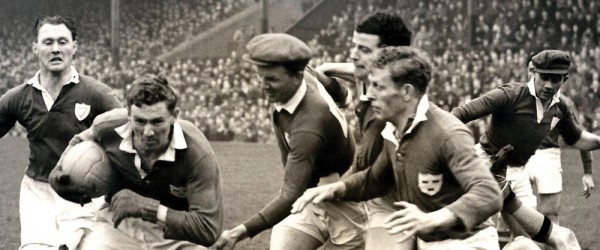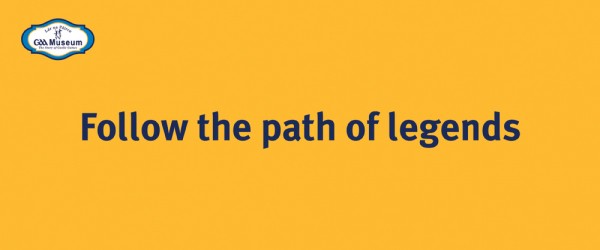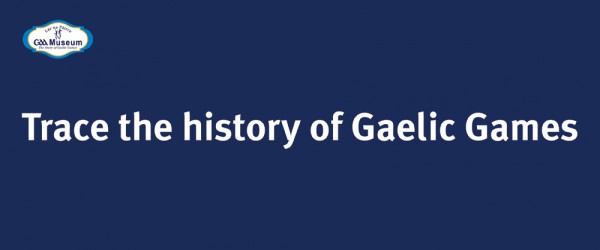No 8. The Croke – Fennelly Cup
The trophy cabinet at Lár na Páirce Museum in Thurles holds a vast array of splendid trophies, all associated with the story of the GAA since its foundation in the town in 1884. Pride of place among them is the Croke-Fennelly Cup, whose amazing story captivates the visitor.
Made of solid silver and lined with the finest porcelain, it was presented to Archbishop Thomas Croke in 1886 by three exiled Irish in America. The inscription on it reads:
The Unchanged and Unchangeable
Archbishop and Patriot
The Joy and Pride
Of
The Sea-divided Gael
This slight tribute
From
Three of them
1886
No information is available on the ‘three of them’. The trophy is in the form of a large silver jug, swinging on silver uprights, with two silver gilt-lined goblets on the sides and a silver ewer beneath. The uprights terminated in a flexible artistic handle.
Following the death of Archbishop Croke in July 1902, the silverware passed into the possession of his successor, Archbishop Thomas Fennelly. In 1908 the archbishop gave the trophy to Archdeacon Innocent Ryan for the purposes of the Fethard tournament to raise funds for the purpose of paying off a parochial debt, due to the renovation of the local church and the building of a parochial residence. This hurling and football tournament was to attain a status, seldom achieved by such a competition. This was mainly due to the fact that the trophy for the winners in hurling was of an exceptionally historic nature. The trophy then became known as the Croke-Fennelly Cup and could be won outright by any club winning the tournament on two occasions.
Tipperary, Kilkenny, Limerick and Cork participated in the tournament. In the semi-final of the tournament Tipperary, Thurles selection, played Redmonds of Cork. Thurles were very determined to win as they wanted to make an emphatic statement that in Tipperary they would never brook defeat. The Cork side was not at full strength, as some of their prominent players missed the train. Thurles had their full team and wasted no time in showing their determination as their first dash ended in a goal. It was all Thurles in the first half, notching up 2-8, while Redmonds failed to score. They did not fare much better in the second half, Thurles having their own way in all quarters. Final score: Thurles 4-12, Redmonds 0-3.
Thurles: Tipperary (Thurles): Tom Semple-Captain, Hugh Shelly, Jack Mockler, Martin O’Brien, Jack Mooney, Tom Kenna, Tom Kerwick, Paddy Brolan, Joe Moloughney, Anthony Carew, James ‘Hawk’ O’Brien (Thurles), Joe O’Keeffe, Bill Harris, Bob Mockler, Jack Gleeson (Horse and Jockey), Tim Gleeson (Holycross), Pat Fitzgerald (Glengoole).
The final of the prestigious tournament, for the Croke-Fennelly Cup, was contested by the Thurles selection and Limerick’s Young Irelands on 12 September 1909. The venue was Flynn’s field on the Cashel road at Fethard. Admission to the final was four pence and for an extra two-pence access was allowed to an exclusive enclosure and for prime viewing of the proceedings the Grand Stand was available for one penny extra . It was a great day in Fethard with bands from Ballinonty, Cassestown, and Littleton, entertaining the gathering and Archbishop Fennelly was present to throw in the ball. The Shannonsiders had high hopes of success and by half-time this was justified, as they led by 1-4 to 0-5. The game re-started with the ‘Blues’ at once clamouring for position but Limerick fought back obstinately and heroically, and showed no signs of surrender. A free taken by Semple was blocked. Coming in with a rush Carew got the ball from Shelly and scored the deciding goal. Towards the close however the tables turned. The mid Tipperary men broke their bonds and mounted into a prominence that gave them victory, and the treasured cup for the first time.
Final score: Thurles 1-11, Limerick 1-7.
Thurles: Tom Semple-Captain, Jack Mooney, Tom Kerwick, Martin O’Brien, Jack Mockler, Tom Kenna, Hugh Shelly, Paddy Bourke, James ‘Hawk’ O’Brien, Paddy Brolan, Anthony Carew, Mickey Ryan (Mac) and Tim Dwyer (Thurles), Jimmy Bourke (Two-Mile-Borris), Pat and John Fitzgerald (Glengoole) Tim Gleeson, (Drombane) . Referee: – M. J. Fielding, Mooncoin.
The famous trophy was presented to Tom Semple by Archbishop Fennelly and in the weeks and months following the victory, the Croke Fennelly Cup was on display in Anthony Carew’s window, South Main St., Thurles.
Croke-Fennelly Cup 1913
As holders of this trophy, Thurles G.A.A. were invited in 1913 to defend their title. The ‘Blues’ were determined to repeat their initial success over Limerick and thus win the Croke-Fennelly Cup outright. Tipperary (Thurles) and Limerick (Caherline) were fixed to meet at Fethard on 10 August 1913. Special trains ran from Limerick, Kilmallock, Clonmel and Nenagh. Two bands were in attendance: – Clonmel War Piper’s Band and Thurles Confraternity Brass and Reed band. Despite the torrential rain, there was a very good attendance. Thurles had a large contingent of supporters present. The tournament trophies were on display and much admired. Because of the weather and the fact that many Limerick hurlers did not travel, there was much speculation as to whether the game would take place at all. Following much discussion J. O’Neill, secretary of Caherline hurling club, declared against playing and offered a ‘walk over’. The referee then awarded the match to Tipperary (Thurles) without a ball being struck. And so the Croke-Fennelly Cup, became the property of Thurles Sarsfields G.A.A. Club.
The inscription on the cup reads: -
Presented by Most Rev. Dr. Fennelly,
Archbishop of Cashel,
To the Best Hurling team in Ireland.
Played at Fethard, Co. Tipperary.
Won by Thurles Blues.
This historic cup had been in the possession of the Thurles club, since they won it outright in 1913. Anthony Carew, the ‘Blues’ famed full-forward, who was also the club’s secretary at the time became the custodian of the Croke-Fennelly Cup. Early in 1930, a fire occurred in Carew’s licensed premises on Lower Main Street (Liberty Square), Thurles. Carew’s premises and the adjoining building, a drapery owned by Eddie Flynn, were gutted. During the course of the fire, Flynn, perturbed for the safety of his own business, was in the ruins of Carew’s and noticed the famous trophy engulfed by flames in the attic. He was successful in rescuing it, in a tarnished condition. The wooden base was completely burned away. Knowing the history of the cup, Eddie informed club treasurer, James Maher, who in the presence of Garda Laurence Kinsella, took possession of the cup. Club chairman, Tom Semple and treasurer, James Maher, were instrumental in having the cup restored to its original condition. A new base was fashioned by Michael Power, a skilled craftsman who worked at Thurles Sugar factory, while the renowned Dublin firm Hopkins and Hopkins refurbished the silverware.
From 1930, the trophy was in the possession of James Maher, Parnell Street, on behalf of the Thurles club. During the G.A.A. jubilee celebrations in 1934, the trophy was put on display in the presbytery on Cathedral Street, at the request of Rev J. J. Meagher, Thurles, who was then chairman of Tipperary County Board.
In August 1942, when Rev. J. J. Meagher was appointed parish priest of Anacarty, he brought the cup with him from Thurles to the west Tipperary village. Here in the parochial house it remained until the mid 1940s, when James Maher collected it and returned it to Thurles. It was put on display in the Thurles Sarsfields trophy case in Glenmorgan House, Parnell Street, Thurles.
In February 1948, it was decided by Thurles Sarsfields Club, to return the cup to the archbishop’s house in Thurles. Archbishop Jeremiah Kinane accepted the cup and the following inscription was added to the wooden plinth: -
Coiste Chumann Iomána agus Peile na Sáirséalach, Dúrlas Éile, a bhronn an corn seo ar a Ghrásta, An Dochtúir Sároirmhidhneach Ó Cuinneáin, Árdeaspag Chaisil agus Imleach Iúir, i Mí Feabhra 1948. Coiméad an corn sa Phálás, Dúrlas Éile feasta.
In 1994, with the opening of Lár na Páirce – Museum of Gaelic Games, in Thurles, Archbishop of Cashel and Emly, Dr Dermot Clifford felt that this was the ideal location for the historic trophy and with the agreement of Thurles Sarsfields Club presented it for display to the new museum.
Lár na Páirce
Museum of the GAA and Gaelic Games






